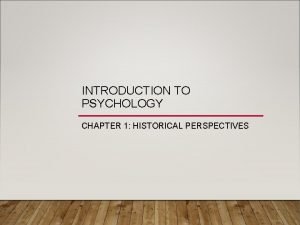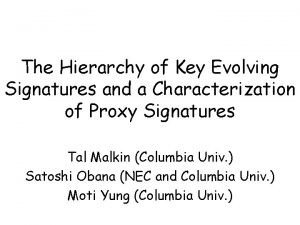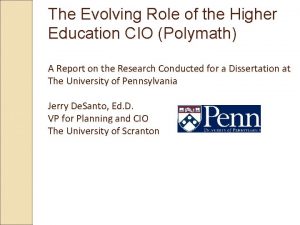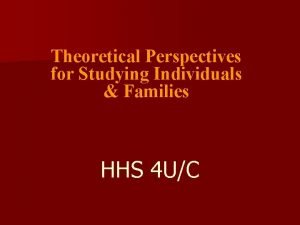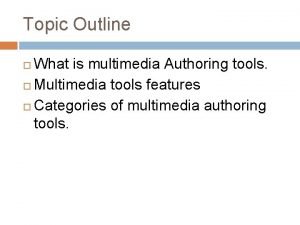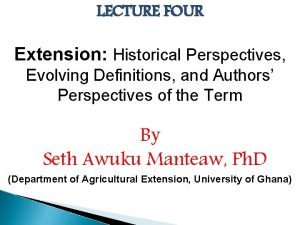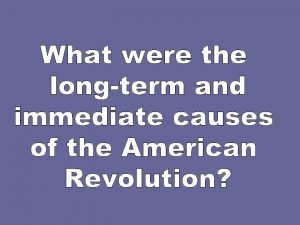LECTURE FOUR Extension Historical Perspectives Evolving Definitions and













- Slides: 13

LECTURE FOUR Extension: Historical Perspectives, Evolving Definitions, and Authors’ Perspectives of the Term By Seth Awuku Manteaw, Ph. D (Department of Agricultural Extension, University of Ghana)

BACKGROUND There is no single accepted definition of extension The meaning of extension has evolved over time and has different connotations in different countries The term originated from academia and its common use was first recorded in Britain in the 1840 s within the context of “university extension” By the 1880 s, it was referred to as the “extension movement” where the university extended its work beyond the campus In the US, the term “extension education” was used to indicate that the target group for university teaching should not be restricted to students on campus, but to people living everywhere. It was seen as a form of adult education

BACKGROUND (CONT’D) The Dutch see extension as “lighting the pathway ahead to help people find their way” The Indonesians followed the Dutch and speak of lighting the way ahead with a “torch” The Germans use the term “enlightenment” in defining extension as it relates to health education The British and the Germans talk of “advisory work” to connote an expert giving advice, but leaving the final decision to the client The Koreans use the term “rural guidance” while the Spanish see extension as an intention to improve people’s skills, although it is usually used to mean “training”

Evolving Definitions There are three dimensions when defining extension: 1. The Enlightenment Definition 2. The Intervention Definition 3. Extension as Communication for Innovation

Enlightenment Definition of Extension The basic thrust of the enlightenment is that “the common folk” are living in the dark and there is a need for well-educated people to “shed” some light. This thinking sees extension within the realm of teacher/student or parent/child relationship placing the extension agent as an “expert” and “sending” position and the client in the “amateur” and “receiving” position This thinking is also in line with the educational dimension of the extension definition. Extension is thus defined as “a service or system which assists farm people, through educational procedures, in improving farming methods and techniques to increase production efficiency and income, better their levels of living and lift social and educational standards” (Maunder, 1973: 3)

Enlightenment Definition of Extension (cont’d) Extension is also “an ongoing process of getting useful information to people (the communicative dimension) and then assisting those people to acquire the necessary knowledge, skills and attitudes to utilise effectively this information and technology (the educational dimension)” (Swanson & Claar, 1984: 1) The belief was that by adopting science-based innovations, farmers would benefit automatically Extension is a deliberate and systematic attemptby means of the transfer of knowledge insightto help develop someone to be able to take decisions (Van Gent & Katus, 1980: 9)

Intervention Definition of Extension The definitions given so far indicate what authors feel extension should be or should do. Extension could also be defined more descriptively in terms of what people who call themselves extensionists actually do. Looking closer at what extensionists do in practice, they actually have little to do with “help” but rather with imposing technologies (Ferguson, 1990) Extension is defined as “an intervention that is undertaken and/or paid for by a party who wants to influence people in a particular way. ” This brings tension between the interest of the extension organisation and the interest of recipients such as farmers. Extension is a “professional communication intervention deployed by an institution to induce change in a voluntary behavior with a presumed public or collective utility (Rolings 1988: 49)

Intervention Definition of Extension (cont’d) The phrase “presumed public or collective utility” is important because it was used to distinguish extension from other forms of communication intervention such as Commercial advertising- goal is to sell products in the interest of a limited group (salesmen, shareholders) Political propaganda-goal is to influence people’s ideological beliefs and perceptions of reality to gain or maintain power Public relations- goal is to manage one’s own reputation or public image. From a purely descriptive point of view, “Extension is everything that people who think of themselves as extensionists do as part of their professional practice (Leeuwis, 2004 p 25)

Extension as communication for innovation Some authors in the field of extension have chosen to completely abandon the notion of extension altogether, which they perceive as misleading. Van Woerkum and Roling no longer use the term, but rather use in universities as Communication and Innovation Studies (instead of Extension Science) Leeuwis and Anne Van den Ban (2004) against this background define Extension as “a series of professional communicative intervention meant to develop and/or induce novel patterns of coordination and adjustment between people, technical devices and natural phenomena to resolve problematic situations.

Extension as communication for innovation (cont’d) The main ingredients of this definitions are as follows 1. Extension is a professional activity, practiced by people who are somehow paid and/or rewarded for it. 2. Extension is regarded as an intervention as it is usually subsidised or paid for by external agencies (donors, govts, private companies) 3. Extension draws heavily on communication 4. Extension is a process involving series of communicative interventions and interactions 5. Extension takes place amid other interactions (actors) 6. Extension is not just dissemination of innovation, it gives room for social processes such as social learning, network building, decision-making, negotiation. 7. Extension is directed at solving problems 8. Extension focuses on innovations.

Key Functions of Extension The key functions of Extension are: 1. 2. 3. 4. Education Information Animation Problem-solving/Assistance

Conclusion: New Thinking and Perspectives on Extension Over time, extension has seen a paradigm shift: From “technology transfer” to “facilitation” From “beneficiaries” to “stakeholders or clients” From “prescriptive or supervisory” to “advisory” From “one-way” to “two-way” Extension aims to help improve something (e. g. farming, health etc) It is a tool for empowerment. It aims to “liberate” rather than “domesticate”

THANK YOU AND GOD BLESS YOU
 Historical and contemporary perspectives in midwifery ppt
Historical and contemporary perspectives in midwifery ppt Historical perspectives of psychology
Historical perspectives of psychology Evolving design
Evolving design A framework for clustering evolving data streams
A framework for clustering evolving data streams Key evolving signature
Key evolving signature Evolving
Evolving Brand leveraging strategies
Brand leveraging strategies Four theoretical perspectives
Four theoretical perspectives Experientalist
Experientalist Icon based authoring tools example
Icon based authoring tools example Multimedia authoring software
Multimedia authoring software Four major perspectives of psychology
Four major perspectives of psychology Extension lecture meaning
Extension lecture meaning 01:640:244 lecture notes - lecture 15: plat, idah, farad
01:640:244 lecture notes - lecture 15: plat, idah, farad

